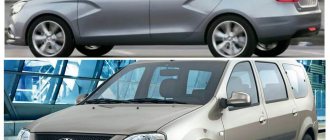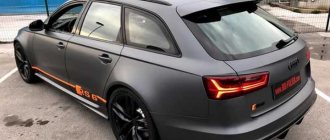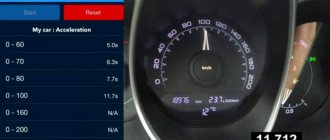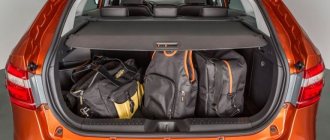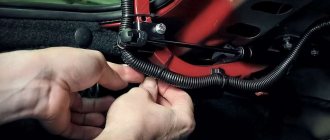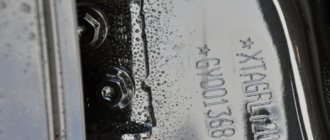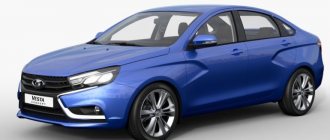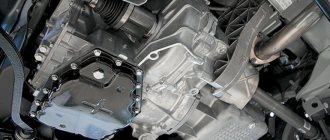- home
- Useful
- …
A lot of controversy has been caused about the modern AVTOVAZ car, which is VESTA. Many do not believe our automobile industry and say that “modern generation” is nothing more than a continuation of the “folk” GRANT, KALINA, PRIOR on the one hand. If we put aside everything else (technical and design), opponents of the brand, often entering into disputes, bring up the following facts - “ it will rot in a couple of years if not treated correctly ”! However, the manufacturer gives a guarantee “for 6 years” specifically on the body, that there will be no signs of through corrosion. And now the concept of “galvanization” begins to blow, opponents will again say that it simply isn’t there (this is a LADA, NOT a MERCEDES), others say that it is there and that the parts are reliably protected. So where is the truth? Today we’ll sort it out whether it’s there or not...
Starting the article, I would like to quote the words of one “mega-expert” from a specialized forum (I will not rewrite it verbatim), but this is the meaning. There used to be VAZ 2101s - the metal was of high quality, that’s why it didn’t rot! But now I don’t understand why, that’s why they cover it with all sorts of crap – “anti-corrosion”, “galvanization” and so on. I would like to immediately object to him, these methods are responses to modern road conditions. Previously, when “KOPEYKA” appeared, there were very few cars, I remember the winters - the snow from the roads was practically not cleared (only the main highways), there were no reagents. And what now - the roads, even at minus 10, are somehow wet, all because they are simply covered in reagents that corrode snow and ice, respectively, the body, paint and even tires (and what can I say, sometimes even boots don’t work for the season). Under such conditions, the entire “2101” would have rotted in a couple of years! So they protect modern cars, in a modern way, excuse the tautology.
Is galvanizing of the body necessary?
Zinc is known for its water resistance, which has made it an essential component of materials designed for long-term use in conditions of constant exposure to moisture. Due to the fact that the car body is made of metal, it is vulnerable to corrosion, which can adversely affect the appearance of the car, and in the future, reduce its strength and shorten its service life.
Body assembly. Photo source: https://club-vesta.ru/ustrojstvo/zashhita-kuzova-lada-vesta-i-iks-rej-otsinkovka-grunt-ispytaniya
A material coated with a layer of zinc later begins to experience the harmful effects of rust, because the anti-corrosion shell is the first to take the blow.
The suspension has at least 4 minuses
During the first months of operation, the Lada Vesta caused the greatest criticism regarding its suspension. Many car enthusiasts complain about various knocks and squeaks. Motor design problem:
- front anti-roll bars, which produce a characteristic creaking sound when the Lada Vesta travels long distances;
- stabilizer struts are knocking;
- sounds appear in the front suspension when turning the steering wheel;
- The shock absorbers in the rear suspension are knocking due to the poor design of the supports, which are being replaced with more elastic and self-absorbing ones.
On average, after 4-6 thousand kilometers, Lada Vesta owners notice and complain about the creaking of the stabilizer rubber bands when going over bumps on the road.
After a run of 40-50 thousand kilometers, play may appear in the lower bearings of the steering knuckle. Low mileage rates according to the average statistical data of the operation of similar units.
Lada models with galvanization
Among the products of the AvtoVAZ concern, not only the Lada Vesta can boast of zinc protection, but also a number of other models:
- Granta;
- Kalina;
- Priora;
- XRay;
- Largus;
- 2123;
- 2108;
- 4×4;
- 2107;
- 111 Oka;
- 2120 "Hope".
In most series, the manufacturer began to use galvanizing technology since 1999. In earlier copies of the listed lines, only general anti-corrosion treatment was used.
Is there galvanization on Vesta?
Rust is a serious threat to the appearance and durability of a vehicle. Therefore, there is no doubt about whether the Vesta has galvanization. AvtoVAZ necessarily treats the outside of the Lada body, applying a layer of zinc to its surface using the cold method. The protective coating is more like painting a car and does not provide a high level of water resistance. Therefore, the result of the treatment is fixed by cataphoresis in order to enhance protection against rust by creating two zinc layers at once.
Body. Photo source: https://hitrostigizni.mirtesen.ru/blog/43448248685/Lada-Vesta—reportazh-s-Izhevskogo-zavoda_(52-foto)?nr=1
During the treatment, the Lada Vesta receives anti-corrosion protection, which, according to the manufacturer, can withstand up to 1,500 hours when tested with salt fog. The next test of the degree of rust resistance was carried out by placing a section of the body with a calibrated cut in conditions equivalent to 4 years of use of the car. The zinc coating also passed this test successfully.
Galvanized sheets are not used during assembly
Dimensions of the Lada Vesta car in comparison with its foreign counterpart. Lada Vesta width
Even a non-specialist can see whether the body of the Lada Vesta shown in the photo is galvanized.
The sheets were cut, bent, welded
Here we see ordinary steel, not coated with anything. Galvanized steel is not used, for which there are reasons:
- Welding only joins uncoated materials;
- It is not clear on which machines to cut and further process galvanized sheets;
- A sheet of steel, galvanized even on one side, will cost 3 times more than regular sheet metal.
A zinc layer that is too thick (20-30 microns) will crack quickly. But VAZ is doing just fine with this parameter.
There are a lot of articles about cold galvanizing at VAZ, and I believed that it is not a layer of zinc that is applied, but a zinc-primer mixture, after which the primer is not applied. But the author writes that a layer of zinc is applied, then a primer in the bath. Why prime again? Why can’t the inside be coated right away or is it expensive?
At first I was also perplexed: they galvanize, but only halfway. For what? And then I remembered: in our country everything comes at some point, good beginnings end in death...
If you coat metal sheets with zinc on both sides, then it cannot be further processed by pressure or bending (it breaks). In the West, galvanization is not used at all.
Yeah, what are the Germans doing then? Almost all of their models are galvanized.
A six-year warranty is a very good period in any case. These cars certainly won’t rust and rot like Nivas.
yeah but it's from through corrosion
There’s no need to spread rot on NIVA, I have a 5-year-old Niva, manufactured in 2011, and it doesn’t think about rotting.
The manufacturer has already galvanized its models. Galvanizing Vesta should improve strength. Well, yes, in any case, a long guarantee.
The main thing is that it exists. Of course, I would like it to be of better quality, but in comparison with the price, this is a very real way out of the situation aimed at reducing the cost of the final product.
a ton of metal is 10,000 rubles three times more expensive = 30,000 rubles, and the car drives quietly and does not stand under a fence!
Renault Logan is galvanized using the electroplating method in an electrolyte bath. Is the Lada Vesta primed with zinc metal? After all, this is not full-fledged galvanization, which is our brains! The warranty on the body is 6 years, and the Koreans have 8 years (with galvanization). zinc metal is not full-fledged galvanization
I asked the question whether the Lada X-ray is galvanized: Some car enthusiasts may be extremely interested in how the car body is galvanized. The process can be described quite simply. The part to be processed (already in finished form, stamped on the assembly line) is immersed in a heat-resistant bath filled with molten zinc. The melting point of zinc is over 400 degrees Celsius, so the entire process is carried out automatically, which ensures high accuracy and quality of processing. Due to the high temperature, a thin layer of galvanizing is partially mixed with the molecules of the metal from which the part is made, thereby ensuring strong adhesion between the part and the shell, which protects it from corrosion. This procedure allows you to completely deprive the workpiece of areas that are not protected from rust. Material from the site: ixraylada.ru Who to believe?
An acquaintance bought a Vesta, drove it down a dirt road to the village, and all 4 doors jammed, he took it to a service center and quickly straightened the body and sold it to the Vesta and draw your own conclusions about what kind of car it is.
Either you or your friend have a rich imagination
I doubt that this is true. I drove the rusty 21083 along the village road, and nothing stuck. Maybe you're talking about the Daewoo Nexia?
This figure filled the entire Internet with this opus, apparently they paid well. Relying on consumer ignorance. There is not a word of truth in the article, it is some kind of ignorant nonsense in reality. All manufacturers weld the body from metal, galvanized on both sides. The strip is galvanized in a metallurgical plant either by immersion in a hot melt or galvanically in a solution. All front parts, partly the bottom and part of the brackets are made of this steel. Most manufacturers make the roof non-galvanized, because it makes no sense and is expensive. This is the same on Vesta, which is why there is a 6-year warranty, which previous models could not have had. Plus, Vesta has three times more protection for seams with mastic and a new technology for protecting cavities with wax. More than two years have passed, but try to find reviews that Vesta is rotting - no. I wonder if this review will pass? I wouldn’t be surprised if all these sites are from the same “manufacturer”.
Georgy, take two galvanized parts and weld them. Then write how it turned out
If you do as you say, then the welding areas are then galvanized again? So why the hell then boil galvanized metal, when you can then galvanize everything at once.
Galvanizing methods
Today, galvanizing the roof or the entire car body is done using four technologies. The differences lie in the cost and quality of the waterproof protection. One method can be used exclusively in the budget segment of cars from manufacturers aimed at the mass market, while the other involves high-quality processing of the body of premium cars.
Hot galvanized
At the factory, molten zinc is poured into the bath, heated to temperatures of 460-500°C. After this, the fully assembled car body is dipped into this liquid, allowing it to adhere to the surface with a layer 13-15 microns thick.
Heat treatment provides the zinc coating with a service life of up to 15 years, and also takes the brunt of damage from corrosion. When the paintwork is mechanically damaged, rust begins to eat the zinc layer, but not the body material itself.
Body protection. Photo source: https://club-vesta.ru/ustrojstvo/zashhita-kuzova-lada-vesta-i-iks-rej-otsinkovka-grunt-ispytaniya
The disadvantages of hot technology include its high price, which is why it is used only in the production of expensive cars of the luxury, premium and business classes.
Galvanic galvanization
The advantage of the galvanic method is the uniform distribution of the zinc-containing layer over the entire surface of the car body. For this purpose, an electrolyte containing a waterproof non-ferrous metal is used.
Body protection for Lada Vesta. Photo source: https://club-vesta.ru/ustrojstvo/zashhita-kuzova-lada-vesta-i-iks-rej-otsinkovka-grunt-ispytaniya
As with thermal technology, with galvanic technology the body is lowered into a bath of liquid, where zinc particles are deposited on the body under the influence of an electric current. Compared to the hot method, the galvanic method is cheaper and provides up to 10 years of service life of the protective layer for the metal of the machine.
Cold galvanizing
The cold galvanizing procedure involves coating the car body with primer, which includes highly dispersed zinc powder. The result is a car with a relatively low degree of corrosion protection, but at a noticeably lower cost.
Cold galvanizing. Photo source: https://topofyoutube.ru/images/9919482
The main disadvantage of the method lies in the fact that even minor mechanical damage to the body, violating the integrity of the soil layer, makes it vulnerable to rust formation. Also, the disadvantages include the difficulty of galvanizing car bodies with a non-standard design, which can result in the formation of areas with uneven coating thickness. At the moment, the manufacturer AvtoVAZ galvanizes the Lada Vesta SV using this technology to save money and ensure a minimum level of water resistance of the body.
Zinc metal
The only zinc processing technology in which a protective coating is applied at the metal rolling stage. The car body is assembled with two waterproof layers on it. A fairly cheap method of coating a car with zinc, which is often used by manufacturers of inexpensive cars in the economy segment.
Vesta body frame. Photo source: https://club-vesta.ru/ustrojstvo/zashhita-kuzova-lada-vesta-i-iks-rej-otsinkovka-grunt-ispytaniya
The main disadvantage of zinc metal is the low resistance of the layers to mechanical damage and not the highest level of protection against rust formation.
Examination
A crossover was selected for inspection for test drives, 1 year old and with a mileage of 6400 km. He was driven onto an overpass, after which a check began. First, it was necessary to determine how well the car was processed from the factory in order to understand what actions to take.
Bottom
When examining the bottom, you can see that from the factory it has been perfectly treated with anti-gravel on the outside, and the welds have also been sealed. Judging by the applied composition, it is noticeable that this was done at the factory, and not at the dealership. In particular, you can find small areas where there is only a primer and no anti-gravel composition. But they are very small, and therefore do not pose a great danger. As a result, after a year of operation there are no noticeable areas covered with rust on the bottom.
Next, one of the plugs was removed from the spar to check how well the plant preserves the elements from the inside. After all, it is inside that corrosion begins to spread first - the formation of condensation, etc. Because of this, welds suffer.
However, in the case of anti-corrosion treatment of the Lada X-Ray, no such troubles were identified. After checking, it turned out that all the cavities were properly filled with a wax-based preservative.
Next, the threshold drainage holes were inspected. They turned out to be not only qualitatively processed (there are traces of excessive leakage of the composition, therefore, the internal cavity of the threshold is covered with anticorrosive), but also completely free, which means that condensate removal is as efficient as possible.
Small pockets of corrosion were recorded on the threads of the bottom studs, since they were not protected by anything. At first, this point will not have any effect, but over time, this problem will progress and later unscrewing the nuts will become problematic, and therefore it is recommended to check the threaded connections and treat them with lubricant.
Rust on threads
All tubes are protected by a special plastic casing, which is made in the form of a grid on the road surface side, which guarantees high-quality removal of moisture, dust and dirt. Naturally, off-road this element will not protect the hoses from a strong impact, however, from the point of view of anti-corrosion treatment of the Lada X-Ray, this decision is certainly correct.
The central tunnel is completely covered with panels made of heat-resistant and sound-absorbing material.
As in the case of the central part of the bottom, the rear spar is reliably protected from the inside - after removing the plug, there is abundant leakage of the wax-based compound.
All checks inside the side members were carried out both visually and using a special probe
It is also important that the preservative does not just lie in spots or concentrate directly at the technological hole, but is evenly distributed over the entire internal plane of the spar
The only weak point is the central part of the spar, where there is noticeably less inside the composition, and therefore it is recommended to independently carry out anti-corrosion treatment on the Lada X-Ray in this direction and eliminate minor defects.
Doors
At the bottom of the front doors there are sufficiently large drainage holes that provide effective moisture removal. Preservative stains are also visible in them. The downside is that there are only 2 holes - at the edges. There is no central hole.
As a rule, AvtoVAZ does not treat the side end of the door from the inside with anticorrosive, and therefore it is recommended to treat this area yourself.
The side end of the front door, which is often not processed
The tailgate features only one drain hole, but it is located at a low point for improved efficiency. There is also a preservative.
The fifth door has several drainage holes, and after checking with an endoscope, it is noticeable that the inside surface of the metal is coated with anti-corrosion.
As you can see, there are no questions about the doors for anti-corrosion treatment of the Lada X-Rey.
Wheel arches
The rear arches are completely covered with lockers with noise-absorbing characteristics (there is a fleecy outer layer).
Myths about galvanizing
Despite the fact that galvanizing technology has been used in the automotive industry for decades, there are still many misconceptions associated with it.
Factory applied zinc layer guarantees complete rust protection
Only premium and luxury car coatings can boast a high level of corrosion resistance. The main task of galvanizing for more affordable cars is to protect the most vulnerable areas of the body - its outer side, areas with welded seams and thresholds.
No additional anticorrosive treatment is required for galvanizing.
Not all zinc coating technologies ensure uniform distribution of the protective layer over the body. Therefore, it is recommended to take care of additional surface treatment with anti-corrosion agent.
Self-treatment with anti-corrosion aerosol can replace the factory
Without specialized education and special equipment, the user can only extend the life of the current anti-corrosion coating and patch up chipped areas.
Where it rusts
There are problem areas on the body of my car. For example, on the front fender and in other places there are abrasions and chips down to the metal, but there is no rust yet. Under the hood I looked at the bolted connections, the joints, so far everything is in order, not rusting.
I found a rusty part under the hood on the right side as the car was moving.
I also found a place with metal corrosion. This is the bottom of the front left door from the inside.
Such body defects can only be found on internal surfaces. This is due to galvanizing technology. They will have to be treated with something, otherwise in 2-3 years there will be through holes. This is how we treat Lada Vesta at the factory. My car is only 3 years old. Surely the body was galvanized poorly and the primer was poorly applied.
Share information about the situation with corrosion on your cars.
Determining the type of galvanization
It is impossible to understand whether the body of a Lada Vesta is galvanized or not by the appearance of the car, because the waterproof layer is placed under the paintwork. To determine the type of galvanization, special tests are carried out with appropriate equipment, which expose the car body to intense moisture.
Body of Lada Vesta. Photo source: https://hitrostigizni.mirtesen.ru/blog/43448248685/Lada-Vesta—reportazh-s-Izhevskogo-zavoda_(52-foto)?nr=1
An ordinary owner of a Lada Vesta SW can clarify the type of protective coating of his car by punching its VIN code. The search results should include information from the manufacturer about the galvanizing method used in the production process. You can also pay attention to damaged areas of the body surface. If no rust appears at the chip site, you can judge the presence of a zinc layer.
Is the body of the Lada X Ray galvanized? Interesting facts about the car, personal experience, price, pros and cons.
Is the body of the Lada X Ray galvanized?
The car cannot be worn out with expensive finishing materials, and they cannot be called overtly inexpensive. But there are no complaints about the fit of the dashboard parts, other parts and interior door upholstery: it is possible, of course, to obviously forget about creaks and other unpleasant things in the interior of this VAZ model. The interior of LADA XRAY is:
- Beautiful design. Just look at the dashboard, taken from its fellow B0 platform and with its inimitable fonts.
comfort and thoughtfulness. This is facilitated by such pleasant little things as, for example, a storage compartment under the front passenger seat or a double bottom in the trunk. Not bad sound insulation, an order of magnitude higher than that of cars previously produced by the automaker.
New Lada X-Ray from the representative of AutoHERMES
Do you want to buy a LADA XRAY in Moscow at a dealer price? Contact a Russian car dealership. AutoHERMES offers successful conditions for the purchase of this Lada X-Ray hatchback in 2016-2017, both on loan and leasing. We are also ready to accept your old car against the price of a new one.
Contact us.
The article talks about whether the body of the Lada X Ray is galvanized, compiled from the opinions and experience of car owners.
prices and options
Informational and entertaining video about whether the body of the Lada X Ray is galvanized, the best moments and comments from the presenters.
You can read the latest news about whether the body of the Lada X Ray is galvanized on our website in the near future.
Р'озможно, неправильные RїР°СЂР°РјРµС‚СЂС‹ соединения пли РЎРЈ Р Р'Р” РЅРµ запущена
lada-vesta.jacrein-club.ru
Coating thickness
Depending on the galvanizing technology used, the car body may have a different thickness of the waterproof layer. With the hot galvanizing method, the car receives a coating of 12-15 microns. Galvanic treatment provides the body with a layer thickness of 5 to 10 microns. A similar value is obtained with the cold method of applying zinc. An exception is zinc metal technology, in which the body is assembled from processed material. Therefore, the thickness of the zinc layer can be from 12 to 25 microns on top of the steel body.
How else to protect the body
The galvanizing procedure alone is not enough to ensure durability of the car body in conditions of contact with moisture. If the outer side of the body is treated with non-ferrous metal, then the internal parts are coated with a primer using cataphoresis. Cataphoresis, as a method of applying primer, is similar to galvanic galvanizing technology and also involves lowering the body into a bath of solution.
Body frame. Photo source: https://www.drive2.com/l/510911993297764839/
Also, as a measure of additional protection against scratches and moisture, it is popular to cover the car with an anti-gravel laminating film over the paintwork.
Electronics and its 5 disadvantages
The quality of the electronics is also disappointing
AvtoVAZ should seriously pay attention to such disadvantages as:
- poor clarity and contrast of the picture on the MMC display;
- Vesta owners complain about rearview cameras turning off while operating in AUX mode;
- interruptions in operation, weak connection with Bluetooth, freezing, after which you need to do a Hard Reset;
- sometimes the heated glass breaks due to firmware or fuses;
- A common problem is a broken ignition coil, which will actually be replaced under warranty.
The car body has a fairly good high-quality galvanized coating, and we consider its resistance to aggressive outdoor environments to be reliable. But it doesn’t come without its downsides:
- Rapid wear of the bumper paintwork;
- Factory wipers are a low quality part, after the first 3-5 thousand km. Scratches and abrasions appear on any glass;
- many car enthusiasts say it is necessary to change wipers after buying a car;
- the seals adhere too tightly to the side windows of the car, particles of dirt, sand and other contaminants get in, squeaking and scratches may appear on the windows;
- manufacturers recommend removing two sides of the seals;
- in first-generation models, dirt accumulated under the hood because a piece of seal was missing in the area of the hood lock.
- A significant disadvantage that affects the operation of electronic sensors and the loss of aesthetic appearance in the engine compartment; there is another drawback, although not significant - the door hinges creak during a short period of operation; they creak during a short period of operation.
Is Lada Vesta rotting?
According to surveys of Lada Vesta owners, the most rust-prone areas of the car are the exhaust system and the underbody. The car body itself suffers from corrosion in the area of the sills and welds on the inside. The design of the car body also has areas prone to moisture accumulation, which makes them especially vulnerable to rust formation.
Rotten Vesta. Photo source: https://club-vesta.ru/ustrojstvo/zashhita-kuzova-lada-vesta-i-iks-rej-otsinkovka-grunt-ispytaniya
AvtoVAZ actually covers the body of the Lada Vesta with anti-corrosion protection based on a zinc layer. However, the manufacturer’s desire to save money forces him to use the cold galvanizing method, which is not enough to provide the metal with reliable and long-term resistance to moisture. The design of the case, which is not devoid of areas in which liquid regularly accumulates after precipitation, is also not in favor of anti-corrosion protection. This brings the owners of Vesta to the need to treat the body with anti-corrosion agent to extend its service life.
Painting Lada Vesta
Thus, Lada Vesta sedans are rolling off the assembly line, fully complying with the standards of the Renault-Nissan Alliance. This is confirmed by inspections that were repeatedly carried out not only by interested amateurs, but also by experts. As it turned out, no cases of underpainting of metal panels, traditional for AvtoVAZ, were noticed. There are no paintwork defects, such as abrasions, scratches and the like, which were often noticed on Priora, Kalina and other models.
Chips are not uncommon for any car, including Lada Vesta. But because of this there will definitely be no “saffron milk”.
But the thickness of the paintwork is not too great. However, this is a modern trend for all cars - constantly tightening environmental standards do not allow applying a deep layer of paint and varnish. On the other hand, even chips do not lead to the formation of rust on the metal panels of Vesta - high-quality soil softens the impacts of pebbles and other road debris without exposing the iron.
The process of processing and painting the bodies of Lada models is clearly described in the VAZ-TV story. True, we are talking about Grants and Kalinas, but the technology for them and for the new sedan is identical -
Painting of the car begins after the application of primer has been completed. Step by step, the car is prepared for the painting procedure. Since painting is done with an aerosol in several layers, robot labor is used. A solution is applied to the surface, strengthening the seams and protecting the body from corrosion. Then noise-insulating mastic is used, which adds silence to the car on the roads.
When applying primer coating with robots, many hard-to-reach places remain and have to be processed manually. The inner sides of the pillars, the edges of the roof covered with doors, are finished manually. The primer comes in two tones: light or dark. Choose depending on the color of the car.
When the body is dried and the varnish is applied, there are a few final steps left, after which we get the product in the form in which it ends up on the market. The final touches are polishing and applying anti-corrosion. The result is a durable, galvanized body of the Lada Vesta. Let us remind you that the thickness of the car’s paintwork is higher than that of other parts of the car, which makes it reliable and resistant to changing weather conditions.

